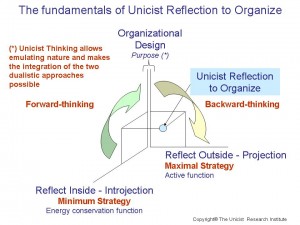IT interface design requires dealing with the nature of work processes. It is necessary to be able to emulate the taxonomy of work procedures.
 The design of interfaces needs to be based on the competencies of the people involved and the available hardware and software.
The design of interfaces needs to be based on the competencies of the people involved and the available hardware and software.
Rationalistic approaches drive naturally towards administrative-voluntaristic approaches to work.
The design of IT interfaces needs to be based on the first two steps of the Unicist Reflection Process which are:
1) Reflecting outside – which means being able to get rid from one’s projections (personal beliefs). This process ends when the operational pilot tests demonstrated their effectiveness.
2) Reflecting inside – which means being able to introject the organizational process using homologous experience. It is a technique implicit in the actors “Method”. This step finishes when homologous pilot tests demonstrated their effectiveness.
The operational pilot tests are the catalysts of the unicist reflection process and the homologous pilot tests are its entropy inhibitor.
It is self-evident that the pilot tests, both the destructive and non-destructive ones, are the key to unicist reflection.
Take your time, invest your energy, the success of the IT interfaces and the building of adaptive systems is the prize.
Learn more at GoogleBooks
